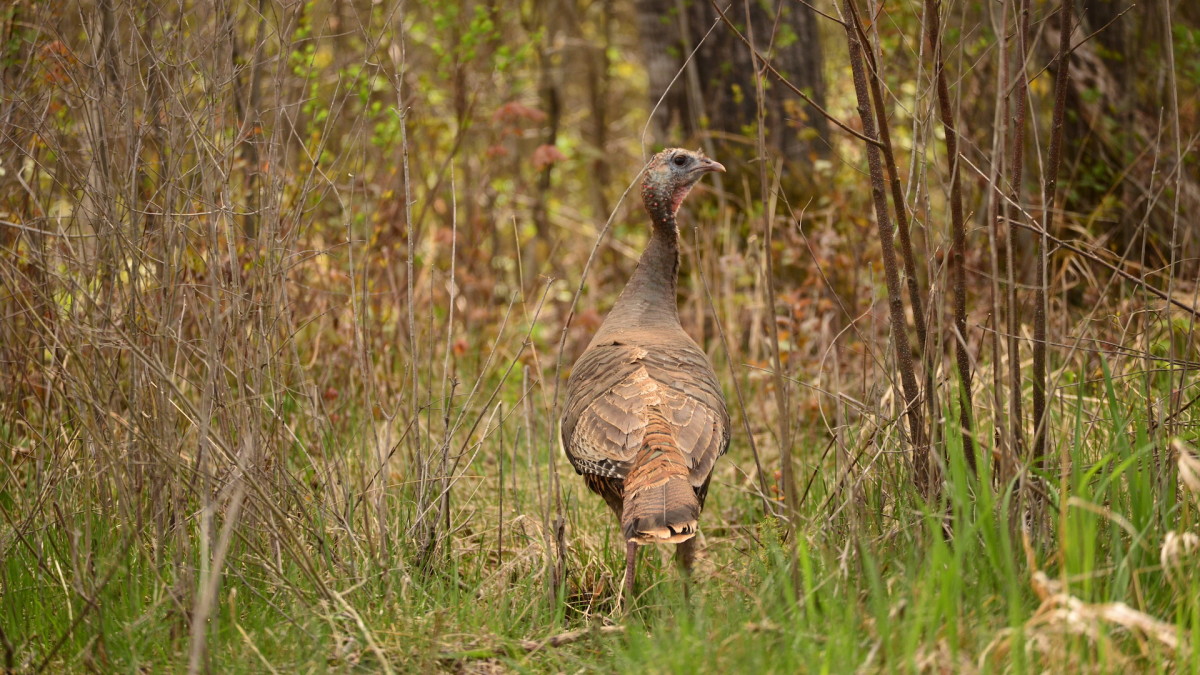
During my formative years of turkey hunting, it was common advice to yelp softly three times and then shut the hell up. I don’t know why this was the standard, but it was. It clearly didn’t originate from hunters who spent lots of time in close proximity to wild hens.
The ladies are vocal, but they need to be relatively close for you to hear much of their chatter because when they are content, they often use their library voices. Having spent a stupid amount of time bowhunting turkeys from blinds, I feel like I’ve heard it all. I also feel like the hunter who hasn’t is missing out on making some calls that can really seal the deal on the whole thing.
Clucks & Purrs
If you use quality decoys and set up on a good food source, it’s only a matter of time before live hens will mix it up with your fakes. When they do, as long as they are relaxed, you’ll hear them purr and cluck.
These two calls are the equivalent of a doe out in the field who keeps her head in the beans and her tail waving back and forth. It’s an all-clear call, and it’s amazing for selling the ruse that your fakes, or your fakes and some real ladies, are just content to be there. I like to use a slate call, or a mouth call, to produce both.
To purr with a pot call, you just have to lightly drag the striker across the surface. With a mouth call, it’s a quiet rolling “R” sound, like if you were trying to whisper in Creole. If you really want to sound like a happy hen, punctuate your purrs with a soft cluck. Real turkeys make this sound a lot, and often if you have a tom that is locked up out of range, this can convince him it’s worth coming closer.
It’s also worth noting that a little scratching in the leaf litter can add a lot of realism to any setup. This is often considered a fall tactic, but it’s just as effective in the spring. Just pay attention to the one, one-two cadence of a real bird, and copy that while you’re calling.
Cutts
Not all outside-the-box turkey calling involves staying quiet. Excited cutting mixed with equally excited yelping can be a great strategy. This is usually not something you hear a hen do when she’s alone—or thinks she’s alone. I don’t know if it’s a dominance thing or what, but if you learn to sharply cutt, and can excitedly yelp during the sequence, you can turn downtime into an adrenaline dump real fast.
I prefer a slate call for aggressive cutting, where you almost pop the striker on the surface. This is easy enough to lead to yelping if you have the skills. A better move is to use a mouth call and a slate call to cutt simultaneously, and then work into some back-and-forth yelping.
It’s also worth noting that if you do call a hen in and she either yelps or cutts at you, you should give her an aggressive cutting sequence back. The loud, staccato-like cutts do something to toms that are in earshot, and in my experience. This almost always gets nearby birds fired up enough to either come in or gobble their heads off.
Cutting also sounds like a call you don’t want to hear, which is a putt. This alarm call is the bane of many turkey hunters’ existence, but there is a way to shut it down. When a hen sees or hears something she doesn’t like, and starts putting, cutt at her—hard. Every time she putts, drown it out with your own cutting. For some reason, this often seems to diffuse the situation and can work to settle the nearby birds down. It’s also worth it if for no other reason than if you don’t, she’s going to leave and let everyone know she’s unhappy.
If you can’t get the right cutting sound with your slate or mouth calls, pick up a box call. This is a great option for loud, crisp, rapid-fire cutting.
Most hunters are aware of cutts, clucks, and purrs, but it’s how they put them to use that matters. Some situations call for a soft, subtle approach, while others require a louder-than-most sequence. Either way, learning how to use the turkey’s language to a higher level will help you call in more longbeards, and is almost a necessity if you hunt pressured birds.
If you want more turkey calling advice, check out these articles: 3 Calling Mistakes Every Turkey Hunter Makes, 3 Turkey Calls Every Hunter Should Own, and How To Call Pressured Turkeys.




